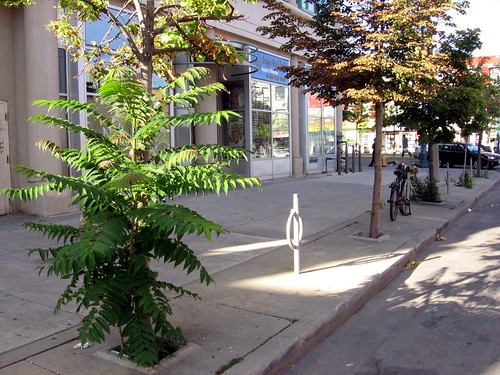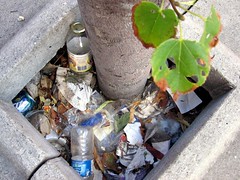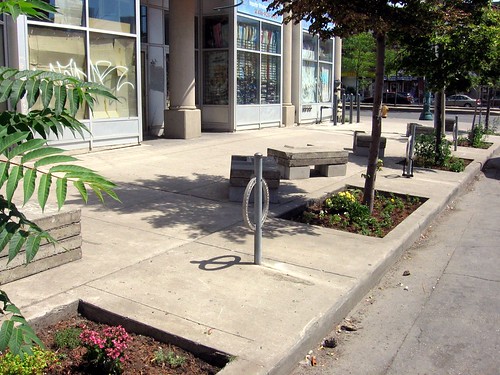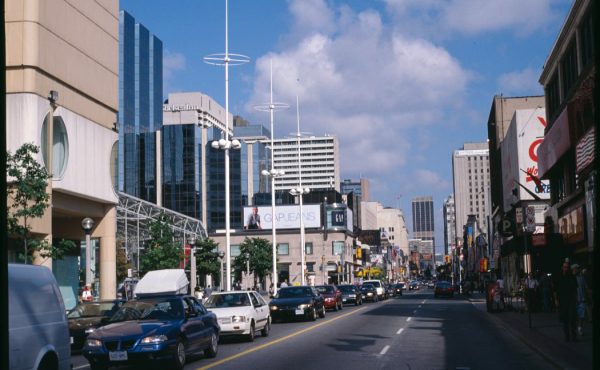
 We posted an event listing the other day about the transformation of a little corner on the eastern edge of Kensington Market at Oxford and Spadina. This wasn’t a City-sanctioned project — instead it was a community intervention to improve the appearance of an intersection and the health of some dehydrated (and possibly dying) trees.
We posted an event listing the other day about the transformation of a little corner on the eastern edge of Kensington Market at Oxford and Spadina. This wasn’t a City-sanctioned project — instead it was a community intervention to improve the appearance of an intersection and the health of some dehydrated (and possibly dying) trees.
I went by late yesterday afternoon to check it out. The photos above and to the right are what the corner looked like in the late morning — the photo below is the final product.

 The team of volunteers from Streets Are For People lifted the cement blocks that were covering the base of the tree. These covers are meant to protect the tree’s root system from exposure to road salt and pedestrian traffic. Instead, the cement is far more destructive by it blocking a fair amount of water from reaching the soil (the tiny holes drilled into the cement covers are meant to funnel water towards the roots but are usually plugged with leaves, soil, or litter).
The team of volunteers from Streets Are For People lifted the cement blocks that were covering the base of the tree. These covers are meant to protect the tree’s root system from exposure to road salt and pedestrian traffic. Instead, the cement is far more destructive by it blocking a fair amount of water from reaching the soil (the tiny holes drilled into the cement covers are meant to funnel water towards the roots but are usually plugged with leaves, soil, or litter).
Even better, the cement covers were converted into benches by being placed on top of donated cinder blocks. The trees provide shade while these new seats provide a resting place for the heavy pedestrian traffic found on Spadina in Chinatown. Residents of the building that face onto this corner have also promised to water the tree pits (now also adorned with flowers).
The before and after photos show the visual benefits of adding (or revealing) softer elements to the streetscape. By including the benches into the scheme, this corner has been changed from a place to walk through into a place to pause and relax.
Check out the project’s photo gallery on Flickr. Photos courtesy of Yvonne Bambrick.




21 comments
Wow, that was a great project. I had walked by yesterday and knew something was different, but couldn’t put my finger on it.
Kudos to all the urban guardeners!!
If you want something done, do it yourself. I like this approach to hacking urban space!
There is an artist in Los Angeles, Richard Ankrom, that fixes highway signs. He dons a mock uniform and often his work isn’t noticed for a while. What is interesting is that he documents everything as if it were performance art.
http://www.thisistrue.com/freeway.html
Excellent work SAFP! When I read yesterday that benches were going to be made out of cinderblocks I thought it might look shoddy but the benches look just fine. Well done!
The trees around the Merchandise Mart Bldg. on Gould St. are in the same type of constricting concrete things. They could use the SAFP treatment too.
This is a crime. You will soon go to jail.
I know it’s now summer, but come winter when the road salt really does get all over the trees what then? Is there a plan to cover things up for the winter?
This is great work dudes.
Cute idea, something of a horror show for blind pedestrians though.
Wow, that’s a big difference. Great project.
Chester > I don’t see how it could be — the benches block anyone from moving into the pits and the benchesw themselves are placed within the proper place of the right-of-way.
As for the salt in winter — i think you have to pick either or. No water in the summer and spring, or no salt in the winter. You can protect the roots by adding on soil (but not too much to compact it) before winter hits. And the City is moving towards a dirt composite and away from road salt.
I think its easier to replenish the roots than it is to re-hydrate a tree. I could be wrong, as my tree knowledged is limited.
Looks great! I worry that the flowers will get trampled in high traffic areas though. Will be interesting to see how things go.
This is great. I’ve actually seen this done on other parts of Spadina (like by the fur shops) and it looks amazing. Crazily enough a whole batch of saplings were planted by Cityplace at Bremner and Spadina and all of them have died (within a year or two of being planted!). I think the city needs to move away from the concrete covers and embrace more open air for the trees. Two trees that need rescuing right now are one at the north-west corner of Queen and Spadina at the McDonalds where the “restaurant” throws its bags and bags of garbage, as well as another tree right across from 299 Queen St. W on the north side that is in front of this convenience store with a merchandise that encroaches on the narrow and high in demand sidewalk; which forces pedestrians to walk on the tree pit space.
Great idea – if you’re looking for another street to liberate, Wellesley on either side of Church has some puny trees that are in need of some help.
Those concrete slabs are there to prevent the roots from being trampled on and the soil from being compacted. Talk to the People at Urban Forestry.
They will be able to tell you why they use those covers.
The City staff has a huge battle trying to get trees to grow where there isn’t any water, where there is vandalism, vehicles and trucks that back over and into trees and tons of garbage and noxious chemicals.
Are you sure that you are not making their jobs any more difficult?
I also notice that in the photographs that an invasive species, Tree of Heaven (Ailanthus altissima) was left to grow besides the Linden street tree that was originally planted in the pit.
If you want to help the native street tree species then be sure to remove these invaders as they will overpower most trees. Better yet, plant a new, hardy, native tree where there isn’t one already.
I don’t understand why they just can’t use the steel covers they use all over the waterfront currently.
Great work! Our office (at Spadina and Phoebe) had the tree pit covers removed by the City last summer and has been gardening there ever since. I think Margie Zeidler’s building at 215 Spadina was the inspiration.
In answer to Alex’s point, the City is quite happy with this program. The problem is that they don’t water the trees enough and they have agreed to do more. The salt issue in winter is somewhat lessened by using a thick layer of protective mulch.
There are issues with trampling, theft of the plants and dog poo, but overall it seems to be a success and really beautifies the street.
I called the City of Toronto – Urban Forestry (416-338-TREE) and asked them to remove the cement blocks from the tree in front of my apartment. It took a couple of weeks but they did it.
AP> I these times when we think the city is falling apart, it’s good to remember that generally the city does work alright.
Tree pit liberation in Toronto’d Kensington Market…
Local group removes the cement blocks that keep water from reaching dehydrated roots system. They in turn use the cement blocks to make benches….
Viva sidewalk liberation! a great bioregional tradition.
Great job! Please liberate the streets of Brooklyn, NY.